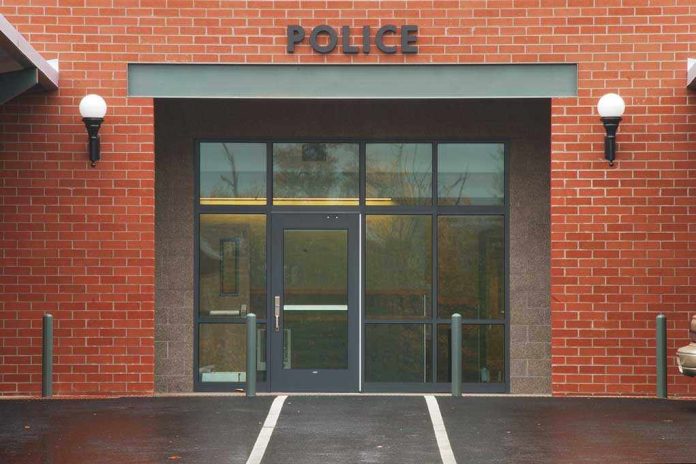
When the walls of a police station crumble under the force of their own evidence, every assumption you hold about law and order, safety, and government oversight is upended in a single, deafening instant.
Story Overview
- An accidental blast of seized explosives at Nowgam police station killed nine, injured 32, and destroyed the facility.
- The explosives originated from a Faridabad investigation and were being examined by forensic and administrative teams.
- The explosion exposed serious vulnerabilities in evidence storage protocols and facility location decisions.
- Political leaders and experts are now questioning the safety of police procedures in residential areas.
Police Station Becomes a Scene of Catastrophe
A police station, once celebrated for cracking terror modules, became the epicenter of disaster on November 14, 2025. Confiscated explosives, seized in Faridabad only days before, were being scrutinized by forensic scientists and administrative officials inside the Nowgam station in Srinagar. The blast that followed was so powerful it was heard 15 kilometers away, rendering the building a heap of rubble and instantly killing nine—including officers, forensic experts, and administrative staff. The shrapnel and shockwave tore through nearby homes, injuring civilians and sending shockwaves through the community.
The immediate aftermath was chaos. Emergency responders evacuated 32 wounded, including 27 police personnel and three civilians, to overwhelmed local hospitals. Families of the deceased and injured gathered in disbelief at the scene, while senior officials, including the Lieutenant Governor and Chief Minister, rushed in for damage assessment and public reassurance. The air was thick with grief, confusion, and the acrid residue of explosives—an agonizing reminder of the risks law enforcement faces when protocols go awry.
From Faridabad to Srinagar: A Chain Reaction
The origins of the disaster trace back to Faridabad where a doctor was discovered with a cache of explosive chemicals. These were seized on November 9-10, transported to Srinagar, and stored at the Nowgam police station under the assumption they would be safely examined and documented. Yet, assumptions proved fatal. The station’s location in a densely populated residential neighborhood magnified the blast’s impact, causing not just governmental loss but civilian distress and property damage. The presence of multiple agencies—police, forensic scientists, revenue officials—underscored the complexity and coordination required, but also revealed systemic cracks in safety oversight.
Questions quickly surfaced about why such dangerous materials were kept in such close proximity to homes. Legislative representatives demanded answers, highlighting an uncomfortable truth: procedural convenience had trumped public safety. The station’s reputation for handling sensitive terror cases made it a logical hub for evidence, but the decision to store explosives in a residential zone now appeared recklessly shortsighted.
Stakeholders in the Line of Fire: Human and Institutional Toll
The casualty list reads like a cross-section of government: law enforcement, forensic scientists, revenue officials, and even crime photographers. The loss of experienced personnel is a blow not just to ongoing investigations—including the high-profile terror module case—but to the community’s trust and morale. The Director General of Police and Lieutenant Governor took center stage at wreath ceremonies, underscoring the hierarchical structure and the gravity of the loss. Families of the dead and injured now face a future colored by trauma, bureaucratic aftermath, and unanswered questions about preventable tragedy.
The ripple effects are immediate and profound. Ongoing police operations at Nowgam are stalled, investigations disrupted, and the region’s sense of security shaken. Forensic and administrative functions will require rebuilding, both structurally and psychologically. The destroyed station is a stark visual of what happens when safety protocols break down at the intersection of government duty and public vulnerability.
After the Blast: Political Scrutiny and Future Reform
As the investigation unfolds, authorities have urged restraint from speculation about the blast’s cause. Yet, public and legislative pressure is mounting. Why were explosives stored in a residential police station? Why didn’t established protocols prevent such an outcome? These questions are not merely local but national in scope, with potential to drive sweeping changes in how evidence is handled, where hazardous materials are stored, and how inter-agency operations are coordinated.
The long-term implications extend far beyond Srinagar. Police departments across India—and possibly worldwide—will be compelled to revisit standards for hazardous material storage, facility location, and staff training. Infrastructure investment will likely shift toward isolated, purpose-built evidence facilities. Enhanced training for forensic teams and improved inter-agency communication will become essential reforms. The tragedy at Nowgam may ultimately serve as a catalyst for better practices, but only if its lessons are heeded and its victims remembered not just in ceremony, but in policy.



